The 1967 Corvette was the best of the best
If the second generation (C2) Corvette is the best Corvette (and it is, just trust me), then surely the 1967 model year is the best C2. And if 1967 is the best C2, aside from some ultra-rare unicorns, the big-block L71 is the best ’67. It’s the cleanest-looking, with that massive stinger hood pointing the way forward, and somehow also the meanest. The triple-carbureted L71’s solid lifters and high compression sounds positively racy, especially breathing through beefy side pipes under the occupant’s hips. It doesn’t take long to see why these cars are so near the top of the collectible Corvette ladder.
The C2 was a massive leap forward for America’s sports car when it burst on the scene 60 years ago after several years of development. Though its drivetrains remained largely the same as 1962’s offerings (four 327 cubic-inch V-8s, now with available in-house Muncie four speeds in place of the Borg-Warner units), the ’63 Corvette was otherwise a very different car. It weighed less than the old C1 thanks in part to thinner fiberglass for the body, but didn’t sacrifice any interior space. Stopping was still by good-old-fashioned drums, but they were beefed up. More importantly, this was the first Corvette given fully-independent suspension—a frame-mounted differential with U-jointed half-shafts were connected via transverse leaf spring out back, while A-arms on coil springs and an anti-roll bar took care of things up front. This was also the first Corvette with an alternator instead of a generator.
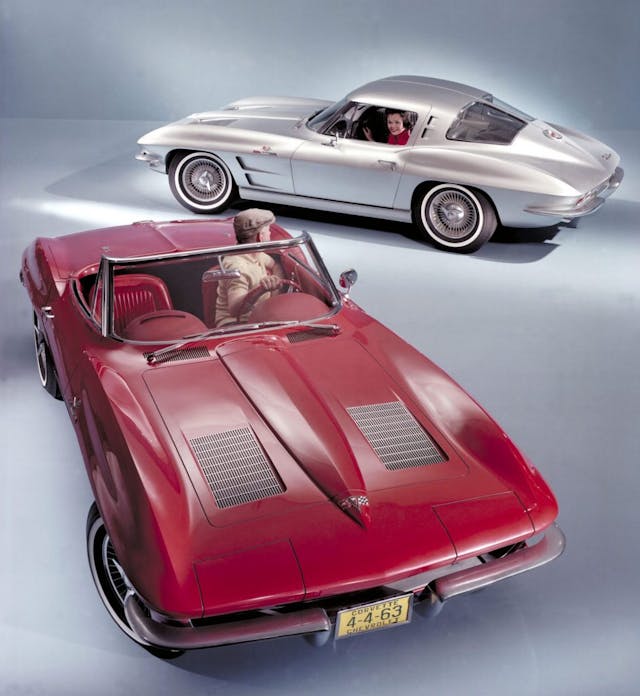
Then there were the looks. It’s easy to get desensitized to mass-produced automobiles, and each new generation of Corvette is not without its cheap details and gimmicky flourishes, but the stylists (under the leadership of Bill Mitchell and Larry Shinoda) really hit it out of the park with the C2’s basic shape. The pointed creases at the tops of the fenders, the lines of the fastback, and the sharp lamp-less nose with its nearly hidden grille made it unlike anything on the road in 1963. Or since, really. Car Life magazine noted that “[t]hey are unique, copy no trend and are exceedingly handsome,” while Car and Driver agreed that “it stands out from its European counterparts as having in no way copied them but arrived at the same goal along a different route.”
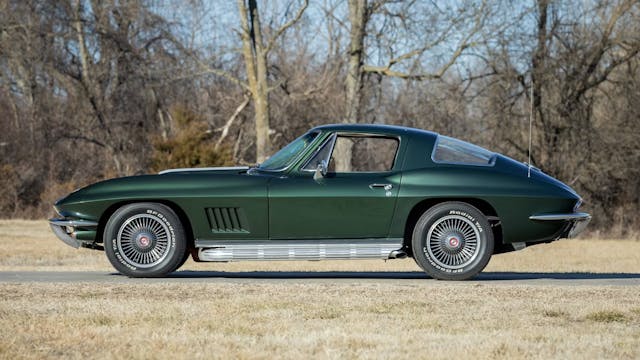
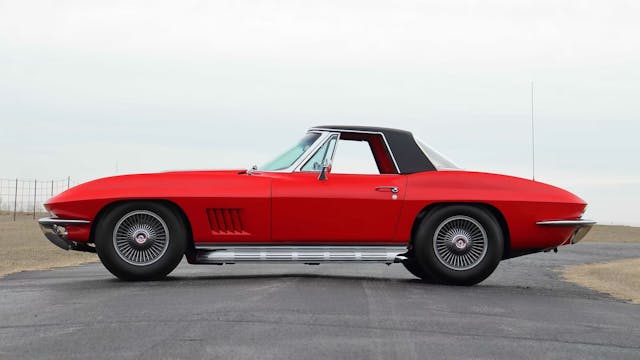
While it borrowed heavily from GM’s experimental 1959 Stingray Racer, this was the first Corvette designed as a coupe (though the convertible remained available) as well as the first one shaped with input from a wind tunnel. Like later C1s, the new C2 also had quad headlights, though in a first for a postwar American car, the Sting Ray’s were hidden by a rotating assembly. This would become a Corvette hallmark, and last until the introduction of the 2005 C6.
On track, the C2 mostly played second fiddle to the Shelby Cobra, but on the road it was a different story. Certainly in performance if not in refinement, the new Corvette matched most European GT cars. Zora Arkus-Duntov, the engineer behind the C2, boasted that “[f]or the first time I now have a Corvette I can be proud to drive in Europe.” Not everyone on the other side of the pond was so impressed, though, as Britain’s Motor Sport magazine griped that the styling, with embellishments like fake hood vents and split rear window was “as vulgar and over-ornamented as the [Jaguar] E-Type is simple and functional.”
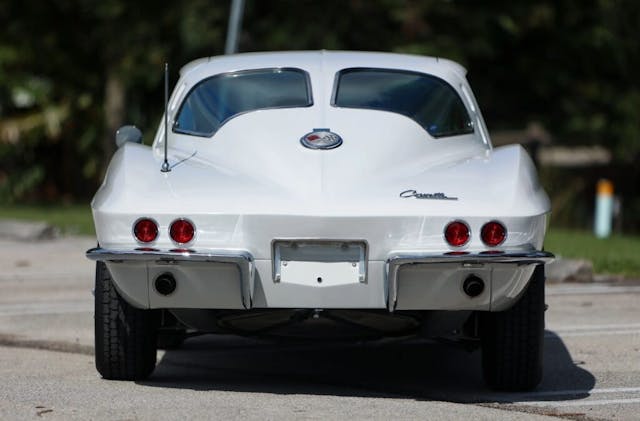
One particular design cue, that split rear window, was divisive even within the halls of GM. Designer Bill Mitchell loved it because it looked good. Engineer Zora Arkus-Duntov hated it because it blocked the driver’s view. Duntov won out as the 1964 Corvette went to a single-piece glass design out back (and got rid of the fake hood vents). Ironically, a ’63 coupe is worth more than the equivalent ’64 today by a wide margin.
Chevrolet sold 21,513 units for the C2’s first year, evenly split between coupe and convertible as well as up 50 percent from 1962. Four 327 engines, three transmissions, and six axle ratios were available. For the C2’s sophomore year in 1964, there were the aforementioned changes to the hood and rear glass as well as fewer ribs for the rocker trim, and improvements to the suspension.
Bigger changes came for 1965. The hood smoothed out and three tall vertical vents came in behind the front wheels. New engines arrived, most important among them being the Corvette’s first big-block, a 396 cubic inch monster rated at 425 hp and codenamed L78. This spelled the end for the 327/375hp Fuelie, the previous range-topper. Few people were enamored enough with fuel injection to spend more money for a slower car than the L78. Injection eventually returned to the Corvette lineup in 1982. Last but not least was the very welcome addition of four-wheel disc brakes, as even the optional sintered-metallic-lined drum brakes of early C2s weren’t up to the task of stopping a big-block. For 1966, that big-block further fattened up to 427 cubic inches and came in either 390- or 425-hp ratings, while the B-pillar on coupes lost its fussy-looking extractor vents.
Which brings us to 1967 …

For starters, a C2 Corvette in 1967 wasn’t supposed to happen—the new C3 was due out that year. Aerodynamic headaches with the next gen’s bodywork, though, resulted in a 12-month delay. By then, the C2 Corvette wasn’t the same fresh face it had been in 1963. The pony car segment exploded, and while Chevy’s two-seat flagship had no direct competitors in the showroom, two upstarts by the name of Camaro and Firebird did offer cheaper ways to go fast. But despite existing in a more crowded field and essentially serving as a carryover, the ’67 Corvette became the best of the breed.
External changes were subtle but enough to easily distinguish the C2’s final year from the rest. A “wolf in wolf’s clothing,” said the promo materials. Most obvious are the five small front fender vents, while a central reverse light above the license plate was added out back. On convertibles, buyers could specify the hardtop with black vinyl covering as was then fashionable, and on 427-powered cars there was a new one-year-only “stinger” pseudo-scooped hood. Ventilated steel “Rally” wheels came standard, while the optional centerlock cast aluminum wheels were now bolt-on and replaced the old spinners for safety reasons. On the inside there was new upholstery, the parking brake handle moved to between the seats, and the cowl on the passenger’s side lost its grab handle. Base price for this final and most refined C2 was $4240.
Technically the top dog in 1967 was the L88 engine option, which essentially got you a slightly stripped track-worthy car powered by a high-compression race engine. But there were just 20 of those built, and today they’re on a different plane of existence when it comes to collectibility. For the average motorist going ’Vette shopping in 1967, the top choices were a trio of 427s, themselves fed by a trio of two-barrel carburetors perched under a triangular air cleaner. This latest “Tri-Power” system detected vacuum through the center carburetor and opened the other two carbs gradually as the throttle demanded more air and fuel. Car and Driver called it “astoundingly tractable” with an “uncannily smooth engine response … as smooth and responsive as fuel injection.” Since Oldsmobile and Pontiac had discontinued their own triple-carb setups after 1966, this was GM’s only such system.
This range of triple-fed 427s started with the 400-horse L68. For $437.10 buyers could get the L71, which came with solid lifters, 11:1 compression, and a 435-hp/460 lb-ft rating. The L89 option then took the L71’s cylinder heads and swapped them for aluminum, but at $368.65 it was a steep ask and just 16 buyers went for it in 1967.
Car and Driver readers voted Corvette “Best All-Around Car” for 1967, and the magazine called it “the most sophisticated passenger car made in America … and among the best engineered sports cars made anywhere.” Testing a 427 coupe, the magazine also recorded a 0-60 time of 4.7 seconds, a feat that’s still pretty quick today and mind-blowing 56 years ago. That didn’t help sales, though, and in 1967 Corvette sales fell to 22,940, their lowest level since 1964. Maybe people were waiting for the new C3. These days, though, the 1967 stands along with the 1963 Split Window as the most beloved C2 while having its ’63 predecessor handily beat on performance.
3754 L71s were produced—considerably more than the L88 and L89, but not exactly garden-variety numbers, either. When well-equipped, the L71’s sticker could add up to around $6000, or just under $55,000 today. For context, that’s about the price of a nicely-equipped new Camaro SS.
The C2 lasted just five model years, and it remains the shortest-lived ‘Vette so far. It also came in only two body styles, but the available engines, paint colors, interiors and options can be dizzying and create a tremendous amount of valuation variation. Narrowing the focus to 1967 enables a bit more clarity.
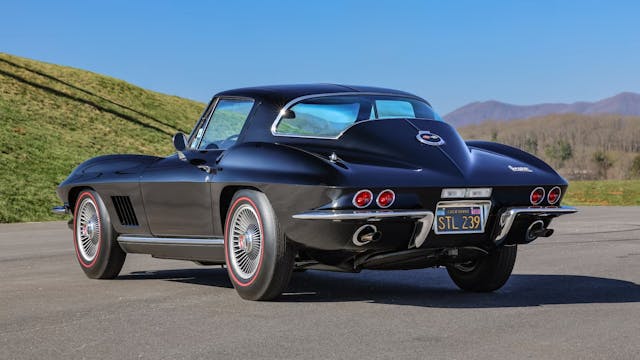
To be up front, no 1967 Corvette is cheap nowadays. Excluding the mythical L88, the model year’s average condition #2 (“excellent”) value is $135,000, well above the $94,600 average across the whole C2 generation. Values for ’67s range from $42,700 for a base 327/300hp coupe in scruffy #4 (“Fair”) condition all the way up to $540,000 for an ultra-rare L89 in #1 (“Concours”) condition, while an L71 coupe runs from $97,600 in #4 condition to $231,000 in #1, and an L71 convertible from $95,600 to $265,000.
Options make a difference, though, and this is more true for vintage Corvettes than nearly any other classic car we can think of. Pricing notes for C2s in the Hagerty Price Guide include -10% for a Powerglide automatic (when available), +$5K for factory air conditioning (when available), +$12K for bolt-on aluminum wheels, +$5K for 36-gallon fuel tank, +$1800 for leather upholstery, +$2500 for power steering, and +$2000 for side exhaust.
Like many high-end American cars, 1967 Corvettes took a serious dip with the onset of the Great Recession. They have since clawed their way up past pre-recession levels except for the L71, which has traditionally been among the most volatile as well as the most expensive of the C2s we regularly see on the market. These cars are also, unsurprisingly, favored by the oldest collectors and enthusiasts. Credit the high cost of entry and the 60-year-old build date.
Long held in high esteem among the bowtie brigade, C2s have been valuable for a long time despite their prolific 117,964-car run. It isn’t particularly hard to find a ’67 in the right condition. Many are quite clean. The important part is finding one with the right options for your wants and needs, for the right price. And since certain option combos carry big price premiums, ’67 Corvettes are one of those cars where authenticity and documentation (build sheets, tank stickers, certifications, etc.) are pivotal. With cars this expensive with details that matter this much, ensuring authenticity can be the difference between a car stealing your heart and breaking it. Consulting an expert is one of those things buyers never really regret, and luckily the community around classic Corvettes is big enough that there will likely be just such an expert near enough to either you or the car.
Aside from calling in for backup, things to look out for when ’67 shopping include the usual stuff like rust. The bodywork may not be metal, but nearly everything underneath it is, and rust-prone areas include the main frame rails, between the rear of the doors and the rear wheels, and inner door frames.
One of the more appealing things about owning a classic car built by the General is parts support. Both small- and big-block V-8s are cheap and easy to rebuild. Same goes for the transmissions. Many of the interior pieces are easy to find as well, while the headlights and some year-specific trim pieces are a little harder.
An L71 occupies an odd place in the market. They’re definitely expensive. There are way cheaper ways to get the crossed flags on your keychain, as well as far cheaper means of going much faster. Then again, Corvettes always offer good value no matter what price point we’re looking at—think of what all the other top-level sports cars from the late 1960s (Cobras, Ferrari Daytonas, E-Types, etc.) cost these days. These last, most refined, prettiest, and quickest versions of America’s sports car’s most celebrated era are high up the Corvette food chain because they deserve to be.
***
Check out the Hagerty Media homepage so you don’t miss a single story, or better yet, bookmark it. To get our best stories delivered right to your inbox, subscribe to our newsletters.
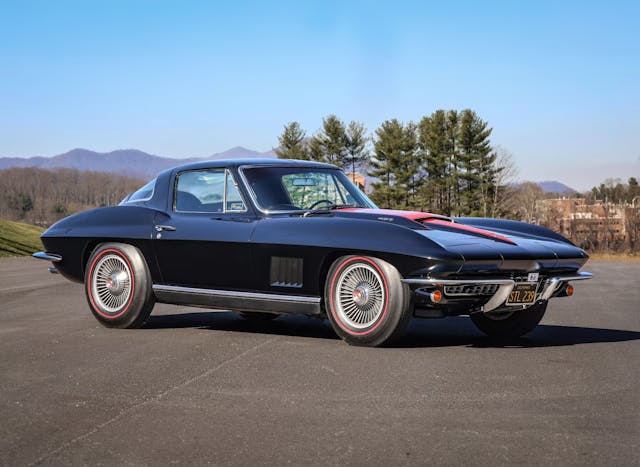
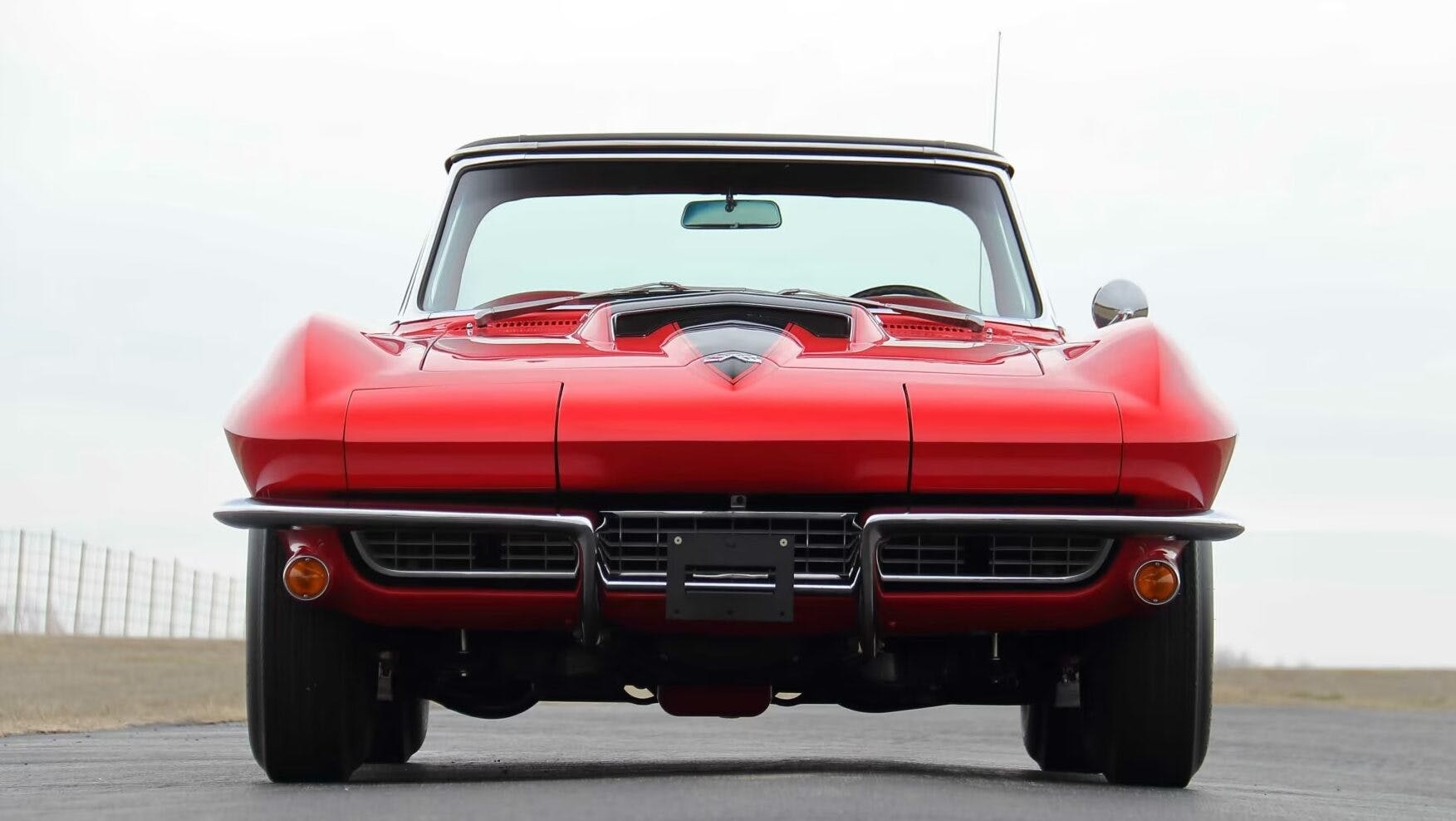

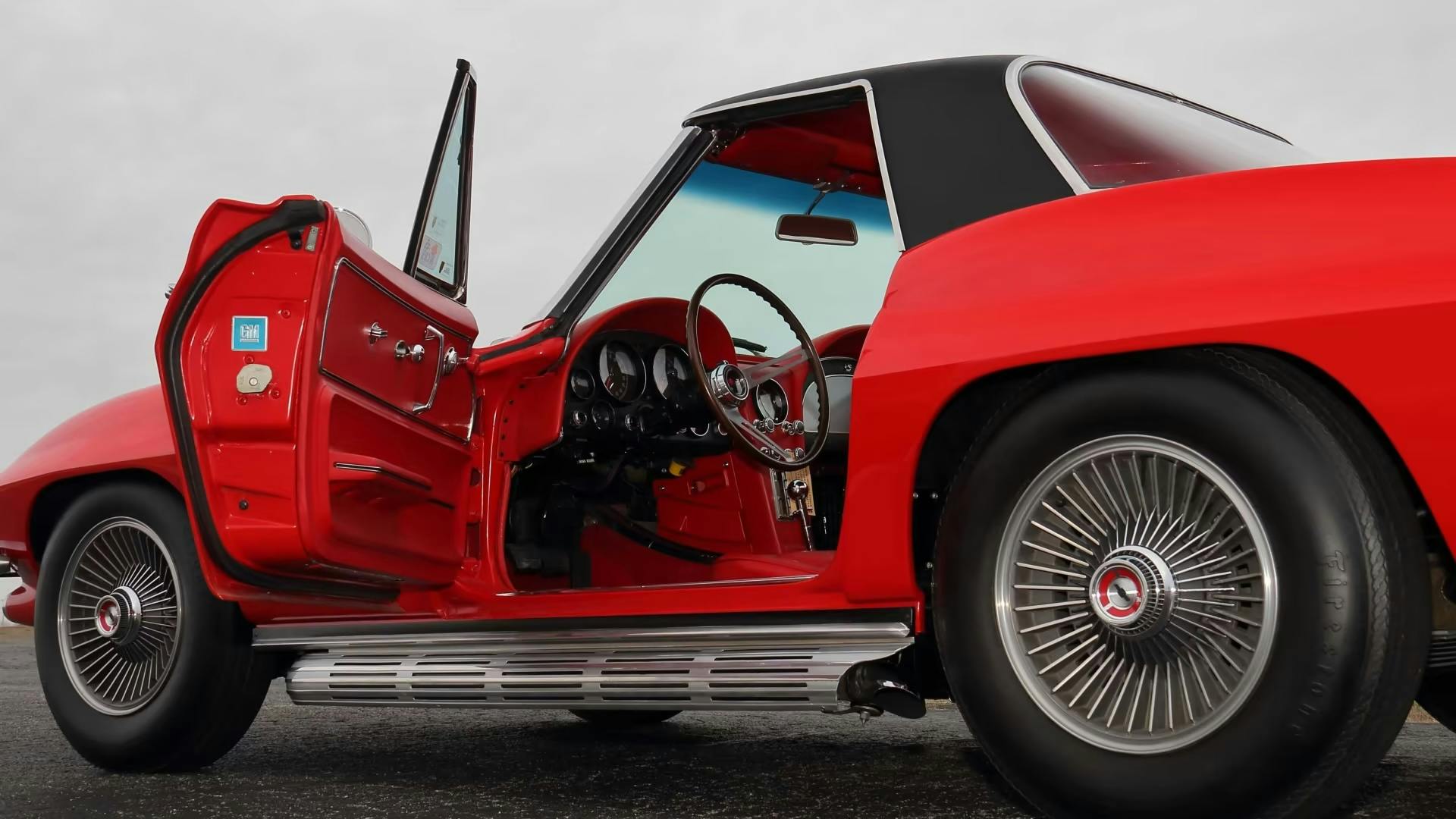

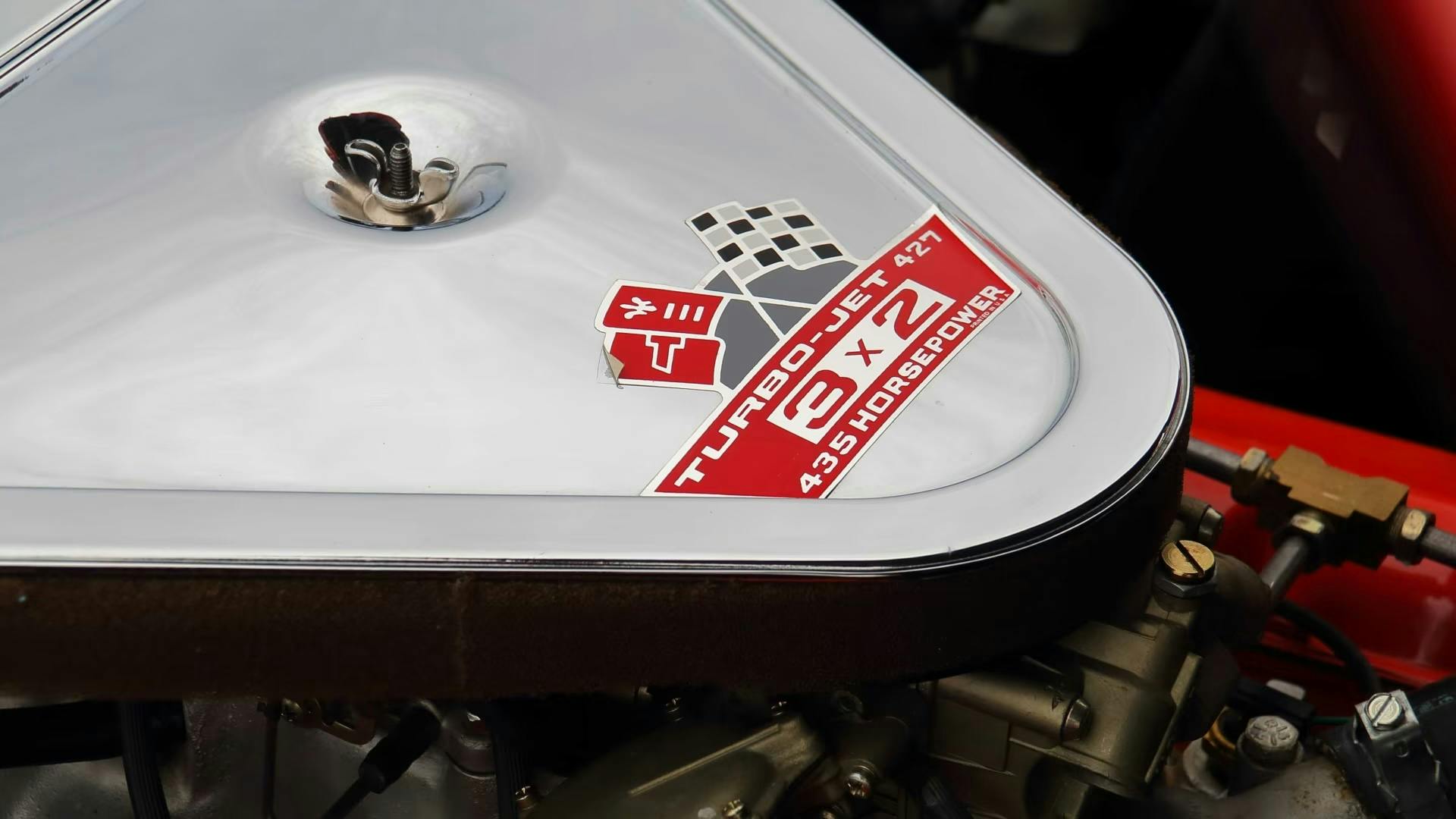
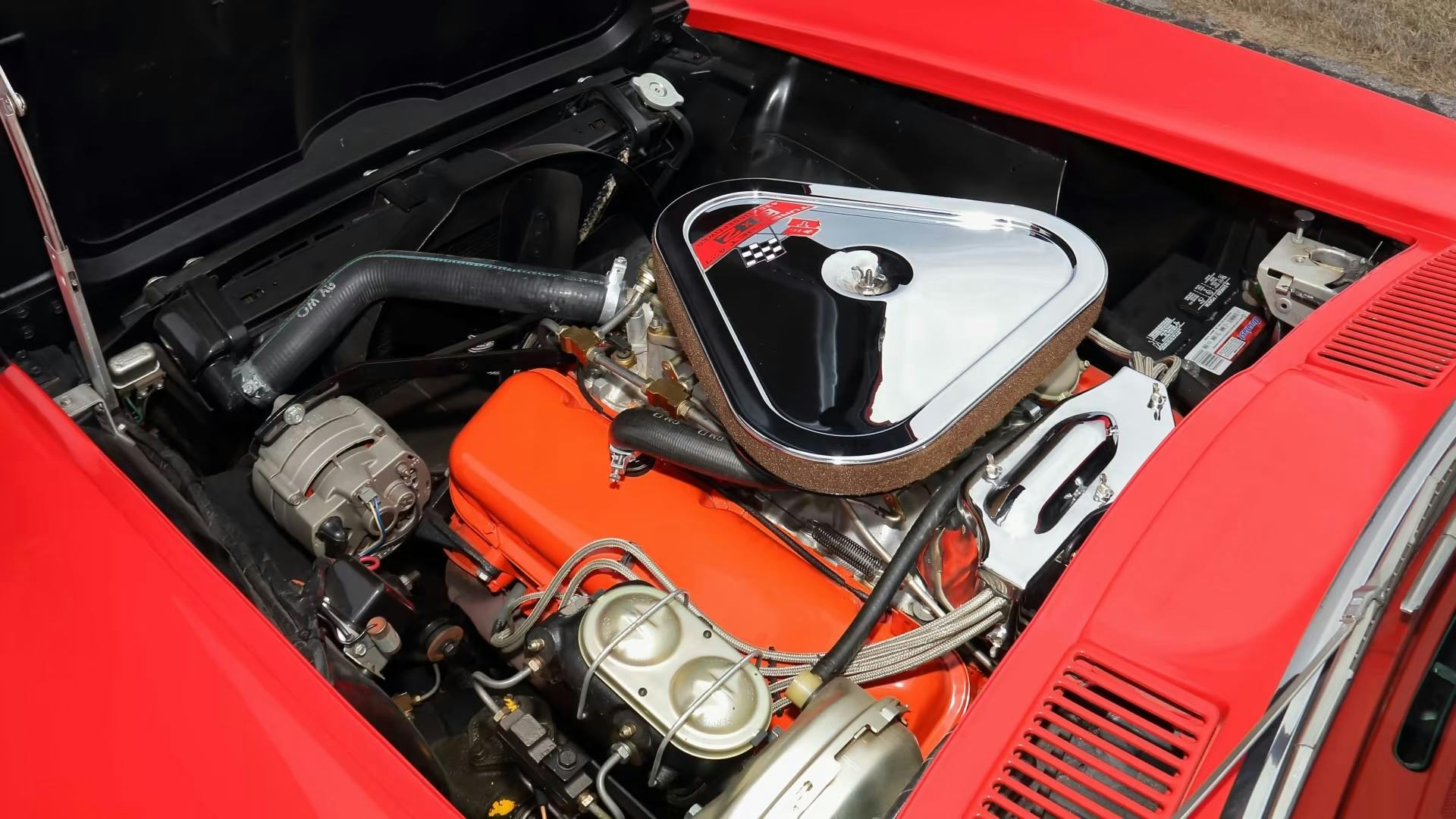


Got (well, actually won) my ’65 in ’99 and have had it since, upgrading many things and enjoying short to very long drives. Amazing how a well sorted C2 can be a great GT car even today. My passion is more driving than preserving, so fortunately the car I won was a driver, with a COPO 454 engine stuffed under it’s hood some time in the early 70’s. The torque that big block delivered felt you’re being rear-ended by a train but it also made the car very nose heavy in the curves making clean post-apex exits difficult. Ran very hot (inside too) and it was a real drag needing to refuel every 2.5 hours on road trips. Today it runs an Edelbrock 350 and Tremec 5 speed, so fuel stops are half as often and the car is SO much nimbler with the lighter front end.
My brother had a ’69 L71 4-speed. I don’t remember what rear end it had, but I know the car had a prettty high top speed so I think the rear end was low (numerically). There was a guy with a 1970 hemicuda, who was the big shot in town. The car wasnt stock either, he had a lot of the typical day 2 modifications like Cragars and a trick exhaust. Looking back I know the hemi was faster than the Vette, but the hemi driver was unable to get the car to hook properly and my brother as able to win 9 times out of 10.
I have owned all 5 years of the C2 Corvettes including a new 1966 roadster…the 67 was supposed be the first C3 series…which was delayed…the designers switched plans adhering to GM orders “change for the sake of change”…which which only destroyed the smooth and unique 65 and 66 interior and exterior design…a huge backup lens, egg crate fender vents, an intrusive emergency brake lever between the seats, and optional Impala hubcaps…the only redeeming item was 427 tripower with a Mopar designed hood scoop…the 67 met the orders to change something but the result fell short…